Grand Jury, Grand Injustice
By Nayaba Arinde and Richard B. Muhammad | Last updated: Dec 9, 2014 - 1:38:16 PMWhat's your opinion on this article?
‘I can’t breathe’ - A movement, not a moment, for justice

Demonstrators stage die-in in front of Chicago’s Third District police station Dec. 6 as part of anti-police brutality and police murder protests around the country. Photo: Haroon Rajaee
|
NEW YORK (FinalCall.com) - Whether it was standing out in a monsoon-like rain, blocking traffic in the dead of night on a busy highway, or totally crowding out popular department stores, forcing shoppers to step over protestors, people from Delhi to New York, from Berkeley to Philly from Chicago to St. Louis took to the streets to protest the non-indictment in the chokehold death of Eric Garner in Staten Island.
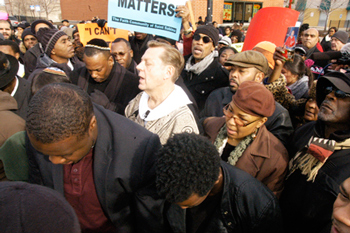
Father Michael Pfleger was among Chicago pastors who took to streets Sunday, Dec. 7, as part of demonstrations against police murders and abuses. Religious leaders and congregations across the city came out of houses of worship to march, halt traffic and engage in civil disobedience in call for change and a demand for justice. Photo: Haroon Rajaee
|
Diverse demonstrators massed to yell, march, wave banners, and chant-in-unison to let governing bodies know they would go quietly into the night in light of a pandemic of police killings of unarmed Black men. They demanded justice, accountability, and a drastic change in policing policies.
The videotape of Mr. Garner, whose choking death was ruled a homicide by the coroner’s office, seemed to push things over the edge. His final desperate plea for life, “I can’t breathe,” became a battle cry for demonstrators.
Nationally protesters engaged in “die-ins,” laying down in streets, stores, shopping centers, highways and almost anyplace that would cause disruption.
In New York City the political Black and Latino, and Asian Caucus walked out of two meetings, and even laid in the street on Broadway, blocking traffic.
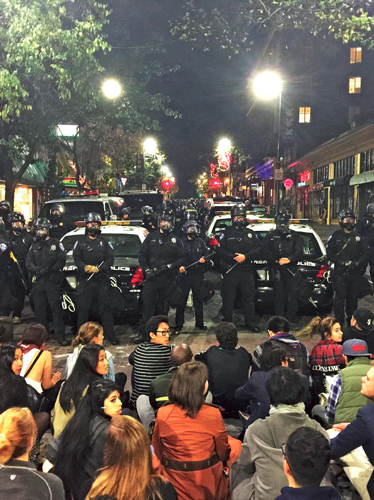
Three officers and a technician were hurt and six people arrested in Berkeley, Calif. when a protest over police killings turned violent, Dec. 7. Photo credit: AP Wide World
|
Civil disobedience has escalated over several months. From vast summer marches in July, to the fires that burned throughout Ferguson in November as the announcement was made that Ferguson cop Darren Wilson would not face charges for killing a Black teenager.
Vocal participants insist that a movement has been birthed. It is organic. It is grassroots. It is the Black youth responding to their condition.
In New York, tens of thousands of people took to streets day and night. They are from all walks of life. Many were young White students having their “protester experience” who stopped traffic on protected commercial thoroughfares, and shut down Broadway, the FDR, the Brooklyn, Manhattan and Verrazano Bridges, the Staten Island ferry, the Westside Highway, and shutdown Macy’s and the famed Apple Store in Manhattan.
Movement–not a moment.
As there was much posturing about a federal profiling bill, President Barack Obama and Attorney General Eric Holder promised to take a serious look into the national dilemma of policing in Black and Brown communities.
Meanwhile, grassroots organizations such as the Zulu Nation, the Malcolm X Commemoration Committee, Operation Power, the December 12th Movement, the People’s Organization for Progress, the Newark AntiViolence Coalition, the Committee to Honor Black Heroes, and Copwatch, Drums, Not Guns, and Pastors United organized and participated in rallies and marches all over the tri-state New York areas.
Across the country other national organizations, like the anti-war and anti-racism Answer Coalition, pastors and grassroots groups engaged in protests.
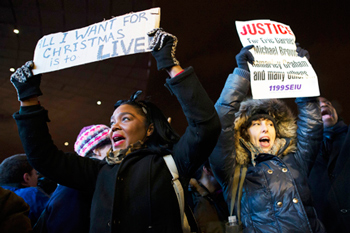
Protestors chant during a demonstration outside the Barclays Center against a grand jury’s decision not to indict the police officer involved in the death of Eric Garner, Dec. 8, in the Brooklyn borough of New York. Photo credit: AP Wide World
|
“I am out here because I am tired of the injustice,” said Constance Graham, mother of Ramarley Graham, who was killed by NYPD officer Richard Haste. Marching both at Foley and Union Square in a single week, she has been on the frontline of several protests for Eric Garner and Mike Brown.
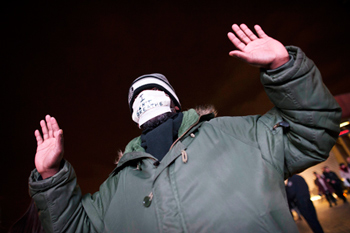
A protestor holds his hands up during a demonstration outside the Barclays Center against a grand jury’s decision not to indict the police officer involved in the death of Eric Garner, Dec. 8, in the Brooklyn borough of New York. Britain’s Prince William, the Duke of Cambridge, and Kate, Duchess of Cambridge, not pictured, attended a NBA basketball game between the Cleveland Cavaliers and the Brooklyn Nets at Barclays Center.
|
Clayburne joined the crowd of several hundred, at Restoration Plaza, saying, “Every time the police kill another child, we mothers have to relive the whole incident again. We are tired. Something has to change.”
Pro athletes, like Derrick Rose of the Chicago Bulls basketball team and Reggie Bush of the NFL’s Detroit Lions, wore pre-game warm-up shirts with “I Can’t Breathe” on them. “We all have, from an athlete standpoint, we all have a voice and I feel we can all be role models and lead by example,” said the star runningback to the media. He described himself as quiet but felt this was a time to speak up. In St. Louis, a message of solidarity was written on the cleats of Rams offensive lineman. It was several Rams players who came out the week before using the Hand Up, Don’t Shoot gesture in tribute to protests in the nearby suburb.
Angry crowds in one California city famous for activism spent much of the Nov. 7 weekend blocking traffic and clashing with police in Berkeley, Calif., an ultra-liberal bastion thousands of miles from the where Michael Brown and Eric Garner were killed.
Protests in Berkeley and Oakland were highly active, reflecting the area’s long history of protest dating back to the 1960s. The demonstrations are also unfolding in a place with strict limits on local police powers.
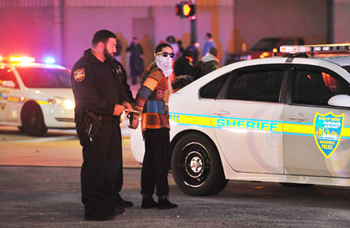
Protesters are detained following their protest on the Hart Bridge in Jacksonville, Fla., Dec. 8. A group of around 20 protesters stopped their vehicles at the top of the Northbound span of the Hart Bridge and began walking in traffic with signs during rush hour. The protesters, who were trying to bring attention to the choke hold death of Eric Garner and police brutality were made to drive off the bridge and park near the off ramp East of EverBank Field where they were then arrested for obstructing traffic. Photo credit: AP Wide World
|
Berkeley Mayor Tom Bates said a tiny fraction of protesters were obscuring the wider message calling for reform of policing policies nationwide.
Merchants cleaned up broken glass Dec. 8 and took stock of the previous night’s looting from downtown Berkeley stores.
While much attention was paid to participation of Whites in demonstrations, polls showed that the country remained divided by race. Bloomberg News reported, “Ninety percent of African Americans thought the grand jury should have indicted in the Staten Island death. Just over half of the White people polled felt that way. On Ferguson, 89 percent of Blacks disagreed with the grand jury, while just 25 percent of Whites did.”
President Barack Obama had hoped his historic election would ease race relations, yet a majority of Americans, 53 percent, say the interactions between the White and Black communities have deteriorated since he took office, according to a new Bloomberg Politics poll. Those divisions are laid bare in the split reactions to the decisions by two grand juries not to indict white police officers who killed unarmed black men in Ferguson, Mo., and Staten Island, N.Y.,” wrote
“As controversy continues to swirl about police officers’ treatment of blacks, an analysis of Gallup data underscores how much less likely U.S. blacks are than whites or Hispanics to express confidence in the police. The analysis also reveals that blacks living in urban areas are significantly less likely than blacks in non-urban areas to say they are confident in the police,” said poll results released Dec. 8.

Father Michael Pfleger was among Chicago pastors who took to streets Sunday, Dec. 7, as part of demonstrations against police murders and abuses. Religious leaders and congregations across the city came out of houses of worship to march, halt traffic and engage in civil disobedience in call for change and a demand for justice. Photo: Haroon Rajaee
|
Pastors and religious leaders took to streets Sunday, Nov. 7, blocking streets and bringing their congregations into the social justice fray. Others had marched in cities like Chicago, Miami, Baltimore and even Huntsville, Ala., during the week. Sunday worship services became the place to speak out against racial injustice in sermons and engage in civil disobedience outside the walls of houses of worship.
“I am just so afraid of what’s happening to our African American men,” said Flora Digby, a 53-year-old Chicago resident who celebrated her birthday by shutting down a major street in front of a church in the South Shore neighborhood.
“This could happen to my nephew, this could happen to my husband. As we allow this to happen and we don’t say anything about it, that means were are in acceptance of it and we are not in acceptance,” she said.
“We are pushed so far that we explode and unfortunately when we explode sometimes we hurt those who are not involved at all. It’s so unfortunate that when we have these explosions and we go and destroy businesses and hurt individuals, we don’t realize we are not helping the situation. We hurting the situation,” said Ms. Digby. That’s why it’s important to have pastors and those who experienced involved in protests to help people understand what’s going on and how to move forward in a positive way, she added.
Eighteen-year-old Niger-Dermonee Moore of Calverton Park, Mo., joined a sit-in in her high school cafeteria and then decided to march to the Ferguson Police Dept. “We’re tired of the injustices,” said she the petite but powerful young Black woman.
“Our school system can’t teach us to survive outside of the school so we’re going to so we’re going take our knowledge elsewhere. The message is that they probably can kill us in the streets, take our sons, take our daughters, our brothers and our sisters, but the one thing they will not take from us is our heart, is our mind, is our knowledge. They cannot take us all out and it is time for this taking us out to end period,” she said.
Her group walked from 10 a.m. in the morning to about 2:30 p.m. “We all talk about change, but what are we actually doing? My spirit is uplifted,” said the McCluer High School student. She and her classmates were joined by students from McCluer North in their protests. It started with messages shared over Instagram.
(Associated Press reporting from Berkeley, Calif., contributed to this report.)
INSIDE STORIES AND REVIEWS
-
-
About Harriett ... and the Negro Hollywood Road Show
By Rabiah Muhammad, Guest Columnist » Full Story -
Skepticism greets Jay-Z, NFL talk of inspiring change
By Bryan 18X Crawford and Richard B. Muhammad The Final Call Newspaper @TheFinalCall » Full Story -
The painful problem of Black girls and suicide
By Charlene Muhammad -National Correspondent- » Full Story -
Exploitation of Innocence - Report: Perceptions, policies hurting Black girls
By Charlene Muhammad -National Correspondent- » Full Story -
Big Ballin: Big ideas fuel a father’s Big Baller Brand and brash business sense
By Bryan Crawford -Contributing Writer- » Full Story






 Click Here Stay Connected!
Click Here Stay Connected!








